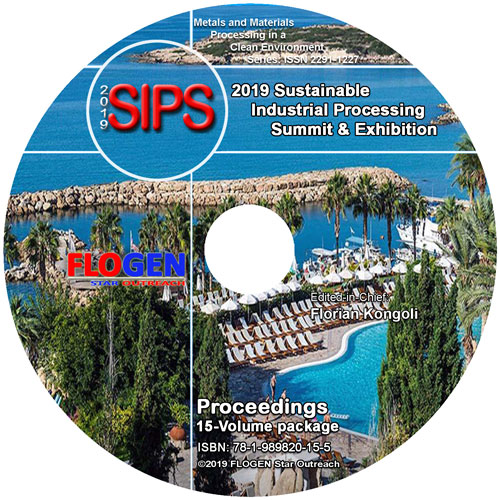2019-Sustainable Industrial Processing Summit
SIPS2019 Volume 8: Usui Intl. Symp. / Advanced Sustainable Iron and Steel Making
| Editors: | F. Kongoli, P. Assis, M.C. Gomez-Marroquin, S. Kitayama, H. Konishi, A. Murao, S. Nomura, H. Ono, H. Saxen, K. Seto, J.I. Tani |
| Publisher: | Flogen Star OUTREACH |
| Publication date: | 20 December 2019 |
| Pages: | 250 pages |
| ISBN: | 978-1-989820-07-0 |
| ISSN: | 2291-1227 (Metals and Materials Processing in a Clean Environment Series) |

CD shopping page
Methods to Remove Tramp Elements in Steel for Recycling Ferrous Scraps
Hideki Ono1; Kenji Taguchi2; Katsuhiro Yamaguchi3; Tateo Usui4;1UNIVERSITY OF TOYAMA, Toyama, Japan; 2NIPPON STOOL CORPORATION, Tokai City, Japan; 3KOBE STEEL, LTD., Kobe City, Japan; 4OSAKA UNIVERSITY, Ibaraki, Japan;
Type of Paper: Regular
Id Paper: 416
Topic: 2
Abstract:
For preserving the environment and preventing the resource depletion, it is important to extend the allowance of recycling low grade ferrous scraps in iron- and steel-making. It is well known that the recycling also contributes to the reduction of carbon dioxide emissions from iron- and steel-making processes. However, lower grade ferrous scraps generally contain more tramp elements, such as copper and tin. It is difficult to remove such tramp elements from molten iron in iron- and steel-making processes. Highly-concentrated tramp elements negatively affect the quality of steel. For example, it is well known that copper in steel causes hot shortness by concentrated melting of copper onto the surface in hot-rolling process.
In this work, the possibilities of removing impurities from molten iron by oxidation and evaporation, which are usual methods in metal refining, are firstly investigated. Of all the elements which are dissolved in molten iron, Cu, Sn Ni, Co, Mo and W are found to be difficult to be removed by such usual methods as oxidation and evaporation [1].
Subsequently, the prospective methods to remove such tramp elements are discussed. Copper, which is one of the most important tramp elements in iron, can be removed by evaporation [2] or by sulfurization [3]. As the other methods, the possibilities to remove copper in molten iron by oxidation [4] and by reduction are considered, and the lowering limits by these methods have been investigated.
Keywords:
Blast; CO2; Copper; Ferrous; Furnace; Iron; Metallurgy; Oxidation; Recycling; Scrap; Steel;References:
[1] H. Ono: CAMP-ISIJ, 31(2018), 40.[2] H. Ono, K. Taguchi, Y. Seike and T. Usui: ISIJ Inter., 43(2003), 1691.
[3] T. Imai and N.Sano: Tetsu-to-Hagané, 74(1988), 640.
[4] K. Yamaguchi, H. Ono and T. Usui: Tetsu-to-Hagané, 96(2010), 531.